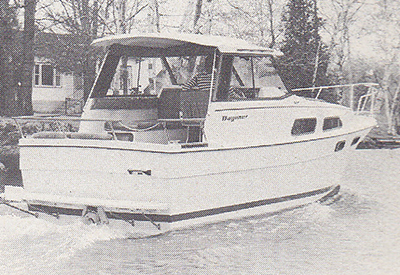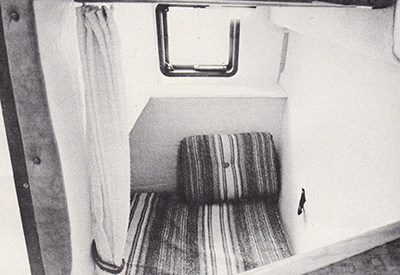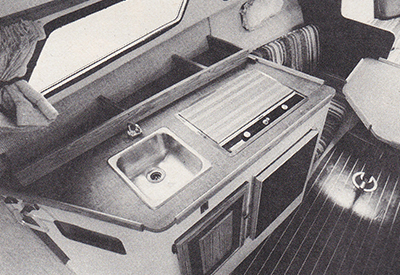Bayliner 2650 Explorer
Written by Andy Adams
Photographs by Peter Richardson
The eight-foot beam and deep sheer give this boat the look of some of the classic offshore power yachts. In fact, it’s a low-priced family cruiser meant for quieter waters.
If the Bayliner 2650 Explorer is a taste of the future of boating, we can look forward to lower purchase costs, lower operating costs and more fun for the buck. In fact, this may be the new boat for first-time boat buyers and folks who previously just couldn’t afford a new cruising boat.
A boat such as the test Bayliner 2650 Explorer can be bought for something in the range of $27 ,000. That’s getting close to the magic (and long outdated) rule of thumb, “a thousand a foot.” That notion takes us all the way back to the early 1960s and is little short of remarkable these days.
There will be some confusion, though, for Canadians who are still reading US boating books in which Bayliner is advertising a base price of under $18,000. It must be remembered that we pay heavy tax and duty on imported boats, plus a 16 per cent currency exchange rate at the time of this writing, and we have more stringent regulations for heads. Moreover, imports into Canada are often sold with options as standard equipment for local conditions, further boosting the price. Still, the Explorer’s relatively low price sets an example that many builders will follow.
 There is bound to be a lot of discussion about just what type of boat this really is. It isn’t a trawler hull; trawlers are heavy, beamy and deep below the waterline. It isn’t a fast planing hull either, being too fine and too deep.
There is bound to be a lot of discussion about just what type of boat this really is. It isn’t a trawler hull; trawlers are heavy, beamy and deep below the waterline. It isn’t a fast planing hull either, being too fine and too deep.
Bayliner describes it as a “lobster boat” design, with a fine entry, semi· displacement-type hull, narrow beam and squared-off transom. The best comparison I can draw is to powerboats of the 1930s and 1940s: narrow-beam boats with shallow draft that were modified in shape to have hard er chines and a supporting planing section aft. These hulls would work reasonably well in the displacement mode at low speeds, climbing their bow waves and planing as further power was applied. Bayliner kept a few old ideas with the new to suit our changing times.
The 2650 Explorer is 26 feet. one inch on the centreline with an eight-foot beam and a shallow, full-length keel, raised cabin and wheelhouse that’s open aft. In its standard US form. the wheelhouse is replaced with a skiff windshield and top, but most Canadian boats will get the hardtop and camper canvas. The cockpit can be further enclosed with an optional full bulkhead and door for those who wish to extend the cruising season to the limits.
An unusual and very important aspect of the Bayliner is the wide choice of power options. There are four optional engines: a 23-hp Volvo diesel inboard, a 36-hp Volvo diesel. a 7o-hp Chrysler Nissan diesel and a 140-hp Volvo gas engine. The standard power is a 120 Volvo gas sterndrive.
Much of the Explorer’s consumer appeal will be due to its interior layout and finish. The V-berth offers generous accommodation for two and has a partial bulkhead at the aft side. Adding curtains will make it a private sleeping area. Portholes on both sides can be opened, and are fitted with screens and elastic-edged covers instead of more space-consuming curtains.
 A dinette area is positioned aft with a seat for two to starboard and a longer seat to port that makes up into a single berth. The table can be removed and stowed under the wheelhouse in straps. The galley is well thought out, with oak sea rails, a two-burner alcohol stove with cutting board cover, a single stainless sink and an ice box by American Formed Plastics. A refrigerator is optional. Fiddles against the hull sides could hold spice bottles and glasses, while a cupboard below the sink takes larger items.
A dinette area is positioned aft with a seat for two to starboard and a longer seat to port that makes up into a single berth. The table can be removed and stowed under the wheelhouse in straps. The galley is well thought out, with oak sea rails, a two-burner alcohol stove with cutting board cover, a single stainless sink and an ice box by American Formed Plastics. A refrigerator is optional. Fiddles against the hull sides could hold spice bottles and glasses, while a cupboard below the sink takes larger items.
To port of the galley is a standing height head with recirculating toilet and a tiny wall-mounted sink. The test boat was not equipped with the shower or hot water options.
The cockpit sole is an unusual bit of work with urethaned teak and holly. All the headliner is a mildew-resistant sound-absorbing material and dome lamps and reading lamps have been placed throughout. The interior is well appointed and has desirable touches such as the teak hand rails mounted on the ceiling and more than six-foot headroom in most areas. However, the fake fur that appears in one or two spots belongs in a California van, not a cruising boat.
The best part of the interior is the unexpected aft stateroom. There it is, lying athwartship under the wheelhouse port side bench seat, with kneeling access from the galley. The berth is 42 inches wide by seven feet long! This additional accommodation is lit by an aft-facing translucent hatch to the cockpit.
Bayliner has once again proven its ability to fit far more accommodation into a small space than almost any other builder. There isn’t a hanging locker, however, or room for the clothes and gear that a group of five would need for a weekend.
 Leading out of the cabin below the translucent hatch is a centre stair with folding teak doors, louvered and thoughtfully equipped with screened backs. In the wheelhouse a bench seat lies against the port side under which is access to the athwartship berth. Three can sit comfortably here while a helm seat to starboard seats two.
Leading out of the cabin below the translucent hatch is a centre stair with folding teak doors, louvered and thoughtfully equipped with screened backs. In the wheelhouse a bench seat lies against the port side under which is access to the athwartship berth. Three can sit comfortably here while a helm seat to starboard seats two.
The cockpit, which extends into the wheelhouse, is more than nine feet long and almost six feet wide. Non-slip fibreglass flooring is similar to the decking. Under the cockpit is the engine, with access through a large lift-out hatch. There’s room to work here plus another access hatch beside that. This second hatch is like no other I’ve seen. It’s plastic, sunk into the flooring and has a snap-down lid with flexible plastic hinges that were showing fatigue on the test boat. It’s not at all typical of the other fittings, most of which are very sea-man like.
The Explorer has stainless steel railings, large marine-finished aluminum cleats, Bomac hatches and portholes with heavy dogs. However, the sliding window in the wheelhouse, while being large and offering excellent visibility, has a centre clip catch. Its action is positive, but will in time scratch the glass.
The Bayliner 2650 Explorer ‘s salty good looks can leave the wrong impression. From a distance, there is an illusion of bigness, an illusion that persists throughout the helm and cabin. In profile the boat is long, with sweeping graceful lines reminiscent of William Garden designs. The Bayliner design staff is responsible, but I suspect the Garden influence from other Bayliner designs such as the 68, Avanzar.
The sheer is fairly deep and the cabin proportions are pleasing to the eye, giving a balanced look. On an eight-foot beam and 26-foot length, this isn’t a large boat, yet the cabin seems to stretch on forever. Part of this is due to the narrow beam, which gives the boat a shape typical of larger yachts.
 I mentioned the boat’s salty character, and with a few lapses (such as the interior fur) there would be little to suggest that this isn’t the hot ticket to offshore cruising. Every boat, though, has certain limitations. In this case some of the boat’s most compelling sales points could be a liability in certain circumstances.
I mentioned the boat’s salty character, and with a few lapses (such as the interior fur) there would be little to suggest that this isn’t the hot ticket to offshore cruising. Every boat, though, has certain limitations. In this case some of the boat’s most compelling sales points could be a liability in certain circumstances.
To be sure, I am impressed with what’s offered, and I’m sure this type of boat signals the shape of things to come. However, what we have here is a boat required to operate with reasonable efficiency in the displacement mode, and to be able to pick up and plane off. To meet those requirements Bayliner had to do some fancy footwork. The hull shape had to be developed to include hard chines and a flat stern in section, to support planing. The keel is needed for accurate tracking, and the long, fine bow shape is needed to give efficient displacement running. Further, the boat had to be made as light as possible, without sacrificing strength, to aid planing with low power.
In the US it has become difficult to get in-water storage for any boat, so marinas are beginning to use dry-slip storage. Some owners, to further pare costs of operation, trailer their boats and store them in the garage or backyard. For these reasons, the Explorer has been given an eight-foot beam. Add to that the requirement for standing headroom and the result is a boat that rolls.
Unfortunately, the standard 120 sterndrive concentrates the weight well back by the transom. When planing, the boat rides high and is not as stable as I’d like. I noticed that shifting the weight of just one passenger caused the boat to change heel. Certainly, trim tabs will help but what all this boils down to is a boat that rolls uncomfortably when planed.
The weight and position of the diesel inboards would change this and improve the situation, while at the same time not planing the rig quite so fast. If you are going to use the Explorer offshore, the diesel option will result in a more competent sea boat. Still, at about 5,500 lbs, it’s light as displacement hull boats go, and narrow too, so roll resistance will never be anything comparable to a beamy planing hull.
 The length-to-width ratio is an asset in some instances. This one will be a joy in a head sea where the fine entry and
The length-to-width ratio is an asset in some instances. This one will be a joy in a head sea where the fine entry and
flared bows will help the Explorer make its way through seas most other 26s shouldn’t be out in. The opposite will be true in a following sea, or quarter sea to stern, where the bow may be harder to control.
If I could be sure that this boat will be bought by well-experienced cruising people, I wouldn’t be going into such detail here, but I anticipate that this may be one of the biggest sellers any cruiser has ever marketed and most will be bought by novice boaters.
Despite appearances, this isn’t 40 feet of offshore trawler. Where the boat will really shine and offer all its best attributes is in situations such as the one we had for our test. Pier Eleven Marina is on Lake Couchiching near Washago. Ontario, on the Trent-Severn system. The area is comprised of quiet inland water and canals. You’re never out in really big water so slow, weekend cruising is at its best. The ability to cruise economically at displacement speeds, with an occasional burst of planing speed, is what the Explorer does best. No one will get seasick and port is never far. The Volvo sterndrive will be at its best here.
Our test boat had the 110-hp four cylinder with an overhead cam, mated to the famous Volvo 270 lower unit. It’s a dependable and economical outfit that has only slight vibration at idle and is very quiet. We got sound level readings ranging from 90 dB at full throttle to 75 dB at 1,750 rpm, which was a 7-mph cruising speed.
The Volvo sterndrive has mechanical cable steering that proved to be light, accurate and easy to handle. One unusual trait is the Explorer’s ability to turn · in the space of its own length at slow speeds. Another is its ability to reverse and turn with uncanny accuracy. In calm water, this boat will track as well in reverse as it will going forward, making docking maneuvers quite simple.
 Much of the credit here should go to the sterndrive. Steering with a rudder in reverse is sloppy whereas the sterndrive can direct the thrust and pull the boat where you want it to go. The lower unit has a power tilt for trailering. and will allow a prop to be changed in the water from the swim grid.
Much of the credit here should go to the sterndrive. Steering with a rudder in reverse is sloppy whereas the sterndrive can direct the thrust and pull the boat where you want it to go. The lower unit has a power tilt for trailering. and will allow a prop to be changed in the water from the swim grid.
The sterndrive offers good overall economy with an estimated four gallons per-hour fuel consumption and cruising speed of 17 mph. That translates to about 4.25 mpg. Better rates could be obtained at slower speeds. The smallest diesel power option is rated at better than 6 mpg, which is excellent.
With the sterndrive we recorded a top speed of 19 mph with three people aboard, and I later got up to nearly 21 mph when I was alone in the boat. This was at 4,350 rpm, just over the maximum recommended speed for the Volvo. In routine cruising we discovered the hull speed to be about 7 mph with the 15×14 three-blade prop.
The Explorer ran 7 mph at 2,000 rpm and 0° running angle. That’s optimum. Increasing the power to 2,250 rpm and then to 2,500 rpm added no speed but increased the running angle to 1.75° as the boat began to plane off. The most comfortable cruising, therefore, is at 2,000 rpm. Beyond that, the boat fights drag and its own head wave all the way up to 3,000 rpm and 9 mph, then suddenly starts to plane and jumps to 15 mph at 3,500 rpm.
Standing at the helm and running the boat through its paces was fun and comfortable. The view is excellent in all directions, the throttle and steering easy and precise and the helm seat well placed with its footrest. The seat can be adjusted for reach or removed for more floor space, and there is ample headroom for standing operation.
 The Explorer exhibits a generally leisurely performance but has enough power to get some prop blow-out and cavitation if the throttle is opened suddenly or a tight full-speed corner is attempted. It responds quickly to the helm, banking into turns at planing speeds, but presents no abrupt changes or surprises under normal circumstances.
The Explorer exhibits a generally leisurely performance but has enough power to get some prop blow-out and cavitation if the throttle is opened suddenly or a tight full-speed corner is attempted. It responds quickly to the helm, banking into turns at planing speeds, but presents no abrupt changes or surprises under normal circumstances.
The future for pleasure boaters seems to include an attempt to balance leisure time with continued efforts to conserve petroleum resources and fight inflation and waste. The Bayliner 2650 Explorer is the sort of boat that will meet these requirements for a great many people. and often will be their first introduction to cruising life.
Originally Published in Canadian Yachting’s July 1980 issue.
Specifications:
Length – 26ft 1in
Beam – 8f
Photo Captions:
Photo 1 -As the bigger powerboat builders go increasingly for the lower power and lower speed market, the Bayliner 2650 Explorer may be known as one of the earliest of the fuel efficient cruisers.
Photo 2 – N/A
Photo 3 – Keeping costs low without cutting down time on the water is going to be important. Although the standard power is a 120 Volvo gas sterndrive, the Explorer comes with a total of four optional engines, a choice that’s unusually generous.
Photo 4 – The gauges at the helm include a tach, oil pressure, fuel and volts and water temperature – with space for a depth sounder plus two small pods for additional gauges.
Photo 5 – N/A
Photo 6 – Some tidy design work on the interior has produced a stateroom under the wheelhouse port side bench, lit by its own translucent hatch. The teak and holly sole is another unexpected finishing touch in the Explorers workable layout.
Photo 7 – N/A
Photo 8 – Galley























